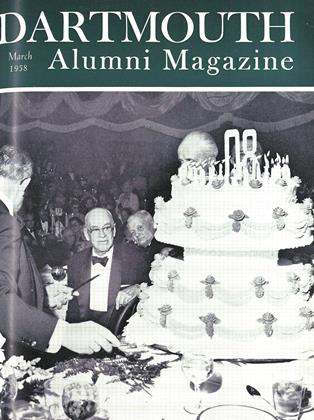WITH the occupancy of the first one of the new Choate Road dormitories late last month, the College announced that by Trustee vote the four residence halls have been named Bissell Hall, Brown Hall, Cohen Hall and Little Hall - all names honoring distinguished Dartmouth men who were benefactors of the College.
The old Bissell Hall, which will soon be torn down to make way for the Hopkins Center, has temporarily been renamed the ROTC Building. The late George H. Bissell, member of the Class of 1845 was a native of Hanover and a pioneer oil man whose interest in research carried on at the College led eventually to the creation of the American oil industry. The building to be razed was given by him as a gymnasium in 1866.
The late Albert O. Brown was a member of the Class of 1881. He was Governor of New Hampshire, 1921-23, and served as a Dartmouth Trustee from 1911 to 1931. His bequest of $500,000 in 1938 now stands on the College books at five times that amount.
The late William N. Cohen, of the Class of 1879, was a Justice of the New York State Supreme Court and was president of the Dartmouth Alumni Council. His unrestricted bequest of more than a million dollars was the largest single bequest ever left to Dartmouth. All students working for the Dining Association receive a stipend from the William N. Cohen Fund to pay for one-third of their board.
The late Clarence B. Little of Pembroke, N. H., was a member of the Class of 1881. He was a banker in Bismarck, N. D„ served as a Dartmouth Trustee from 1921 to 1941, and was president of the Alumni Council from 1915 to 1920. An endowment fund of $136,000 and a plant fund of $38,000 bear his name.
Little Hall is the first of the four new dormitories to be occupied. Sixty-six men who previously resided in College Hall, South Hall and the bachelor flats of Wigwam Circle were moved there last month. At no extra charge they will finish out the present academic year in their brand-new, furnished quarters.
The new dorms, offering eight-man suites with a living room and single and double study-bedrooms, represent a bold innovation on the Dartmouth campus designed to make student living an integral part of the educational process. For each pair of halls there is a large common room for group social life and the entertainment of guests, and off each common room there will be a three-bedroom faculty residence, private yet accessible to the stu- dents. The resident faculty members are envisioned as focal points around which a stimulating intellectual and social atmosphere can be established.
The new dorms are constructed of red brick and concrete block liberally interspersed with glass and white woodwork, combining the basic architectural motif of the campus with the advantages of spacious, contemporary design. The two large common rooms are reached by enclosed glass ramps. The combination of small study-bedrooms, a moderate-sized living room for each suite, and the large, central lounges offers the student residents both privacy for serious academic work and attractive, comfortably furnished quarters on two scales for social activities. A public address system, with a speaker in each suite, will make it easy to call men to the telephone.
All four dormitories will be ready for occupancy when College opens next fall.
 View Full Issue
View Full Issue
More From This Issue
-
 Feature
FeatureThe State of Our Purposes ... and Vice Versa
March 1958 -
 Feature
FeatureA Spot of Green at Knob Lake
March 1958 By ALAN COOKE '55 -
 Feature
FeatureA BIG NIGHT AT THE WALDORF
March 1958 -
 Feature
FeatureAlumni Council Has Record Attendance
March 1958 -
 Class Notes
Class Notes1918
March 1958 By ERNEST H. EARLEY, W. CURTIS GLOVER, RICHARD P. WHITE -
 Class Notes
Class Notes1930
March 1958 By RICHARD W. BOWLEN, WALLACE BLAKEY, JOHN F. RICH







